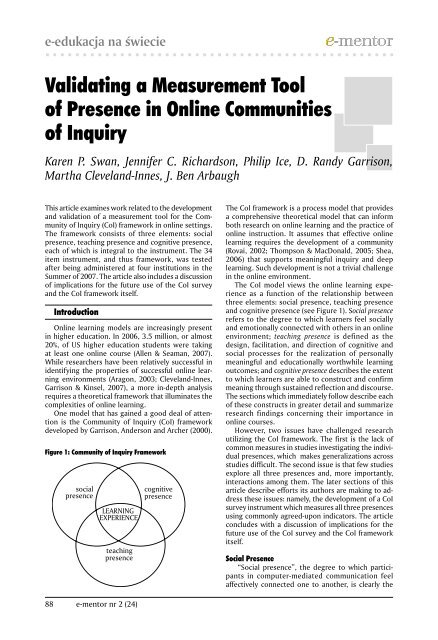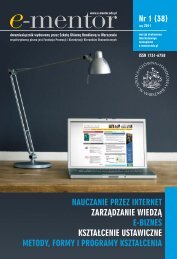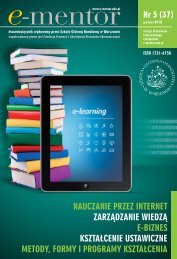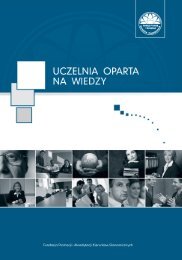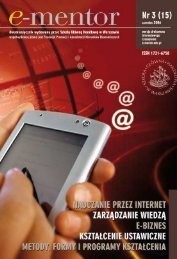e-edukacja na świecieValidating a Measurement Toolof Presence in Online Communitiesof InquiryKaren P. Swan, Jennifer C. Richardson, Philip Ice, D. Randy Garrison,Martha Cleveland-Innes, J. Ben ArbaughThis article examines work related to the developmentand validation of a measurement tool for the Communityof Inquiry (CoI) framework in online settings.The framework consists of three elements: socialpresence, teaching presence and cognitive presence,each of which is integral to the instrument. The 34item instrument, and thus framework, was testedafter being administered at four institutions in theSummer of 2007. The article also includes a discussionof implications for the future use of the CoI surveyand the CoI framework itself.IntroductionOnline learning models are increasingly presentin higher education. In 2006, 3.5 million, or almost20%, of US higher education students were takingat least one online course (Allen & Seaman, 2007).While researchers have been relatively successful inidentifying the properties of successful online learningenvironments (Aragon, 2003; Cleveland-Innes,Garrison & Kinsel, 2007), a more in-depth analysisrequires a theoretical framework that illuminates thecomplexities of online learning.One model that has gained a good deal of attentionis the Community of Inquiry (CoI) frameworkdeveloped by Garrison, Anderson and Archer (2000).Figure 1: Community of Inquiry FrameworkThe CoI framework is a process model that providesa comprehensive theoretical model that can informboth research on online learning and the practice ofonline instruction. It assumes that effective onlinelearning requires the development of a community(Rovai, 2002; Thompson & MacDonald, 2005; Shea,2006) that supports meaningful inquiry and deeplearning. Such development is not a trivial challengein the online environment.The CoI model views the online learning experienceas a function of the relationship betweenthree elements: social presence, teaching presenceand cognitive presence (see Figure 1). Social presencerefers to the degree to which learners feel sociallyand emotionally connected with others in an onlineenvironment; teaching presence is defined as thedesign, facilitation, and direction of cognitive andsocial processes for the realization of personallymeaningful and educationally worthwhile learningoutcomes; and cognitive presence describes the extentto which learners are able to construct and confirmmeaning through sustained reflection and discourse.The sections which immediately follow describe eachof these constructs in greater detail and summarizeresearch findings concerning their importance inonline courses.However, two issues have challenged researchutilizing the CoI framework. The first is the lack ofcommon measures in studies investigating the individualpresences, which makes generalizations acrossstudies difficult. The second issue is that few studiesexplore all three presences and, more importantly,interactions among them. The later sections of thisarticle describe efforts its authors are making to addressthese issues: namely, the development of a CoIsurvey instrument which measures all three presencesusing commonly agreed-upon indicators. The articleconcludes with a discussion of implications for thefuture use of the CoI survey and the CoI frameworkitself.Social Presence“Social presence”, the degree to which participantsin computer-mediated communication feelaffectively connected one to another, is clearly the88 e-<strong>mentor</strong> nr 2 (24)
Validating a Measurement Tool of Presence...longest researched of the three presences in theCommunity of Inquiry (CoI) framework. Indeed, socialpresence research predates the creation of theCoI model by two decades. It arose from a commonconcern among some Communications scholars thatcomputer-mediated communication might preventstudents from developing the sense of belonging withother students, instructors, programs of study andeducational institutions which social learning theories(Vygotsky, 1978) and immediacy research (Weiner &Mehrabian, 1968) suggest support learning. Researchby Gunawardena (1995) and Gunawardena and Zittle(1997) moved the definition of social presence from itsoriginal focus on the capacities of the media involvedto one that focused more on individual perceptions,and so the concept of “social presence” evolved to“the degree to which a person is perceived as ‘real’ inmediated communication” (Gunawardena and Zittle,1997, p 8).Social Presence and Student’s Learning. A number ofstudies followed which examined the perception ofinterpersonal connections with virtual others as an importantfactor in the success of online learning (Swan,2002; Tu, 2000), specifically student’s perceived or actuallearning. Richardson & Swan (2003) examined students’perceived social presence and its relationship totheir perceived learning and satisfaction with courseinstructors. They found all three variables highlycorrelated and a regression analysis showed that 42%of the variability in perceived learning was predictedby perceived social presence. Picciano (2002) investigatedperceived social presence, interactivity, andlearning among students enrolled in an online courseand found strong correlations among these variables.While he initially found no correlations between thesevariables and actual performance on tests or writtenassignments he discovered that by dividing studentsinto groups perceiving low, medium and high socialpresence there were significant differences; studentsin the high social presence group scored higher thanthe medium, and the medium group outscored thelow social presence group.Social Presence and the CoI Framework. It is thissense of “social presence” that Garrison, Andersonand Archer (2000) incorporated into the CoI model.Their research team (Rourke, Anderson, Garrison &Archer, 2001) looked for evidence of social presencein the transcripts of online discussion. They identifiedthree categories of social presence indicators basedon research on immediacy in face-to-face interactions(Weiner & Mehrabian, 1968) - affective responses,cohesive responses, and interactive responses – anddeveloped coding protocols using these indicators.Rourke et al. (2001) established the indicators asreliable in a pilot content analysis of two online classdiscussions, and documented the use of such indicatorsto project social presence in text-based onlinecommunication.Social Presence and Course Design. Noting the relationshipbetween perceived presence and success inonline courses, Tu (2000) linked the development ofsocial presence in online courses to course design.Based on elements of social learning theory, hedistinguished three dimensions of course designswhich influenced the development of social presence– social context, online communication, andinteractivity. Tu and McIsaac (2002) found somesupport for these dimensions of social presence ina factor analysis of student responses to an onlinesurvey concerned with computer-mediated communicationtools. They argued that these dimensionsshould be taken into consideration in the design ofonline courses.Similarly, Swan and Shih (2005) found some supportfor the impact of course design on perceptionsof social presence in a study they did on developmentof four online classes. They found that course (design)alone of seven variables (including instructor, class,age, gender, online experience, and time spent indiscussion) significantly affected perceived socialpresence. Their findings also show an overlap inperceptions of instructor and peer presence and indicatethat the perceived presence of instructors maybe a more influential factor in determining studentsatisfaction than the perceived presence of peers.Teaching PresenceGarrison, et. al. (2000) contend that while interactionsbetween participants are necessary in virtuallearning environments, interactions themselves arenot sufficient to ensure effective online learning.These types of interactions need to have clearlydefined parameters and be focused toward a specificdirection, hence the need for teaching presence. Anderson,Rourke, Garrison, and Archer (2001) originallyconceptualized teaching presence as having threecomponents: (1) instructional design and organization;(2) facilitating discourse (originally called “building understanding”);and (3) direct instruction. While recentempirical research may generate a debate regardingwhether teaching presence has two (Shea, 2006; Shea,Li, & Pickett, 2006) or three (Arbaugh & Hwang, 2006)components, the general conceptualization of teachingpresence has been supported by other research(Coppola, Hiltz, & Rotter, 2002; LaPointe & Gunawardena,2004; Stein, Wanstreet, Calvin, Overtoom, &Wheaton, 2005).Instructional (Course) Design and Organization. Anderson,et. al. (2001) describe the design and organizationaspect of teaching presence as the planningand design of the structure, process, interaction andevaluation aspects of the online course. Some of theactivities comprising this category of teaching presenceinclude re-creating Power Point presentationsand lecture notes onto the course site, developingaudio/video mini-lectures, providing personal insightsinto the course material, creating a desirable mix ofand a schedule for individual and group activities,and providing guidelines on how to use the mediumeffectively. These are particularly important activitiessince clear and consistent course structure supportingengaged instructors and dynamic discussionskwiecień 2008 89
- Page 2 and 3:
3 Od redakcji3 Aktualności4 Noweli
- Page 4 and 5:
Nowelizacja regulacji dotyczących
- Page 6 and 7:
metody, formy i programy kształcen
- Page 8 and 9:
metody, formy i programy kształcen
- Page 10 and 11:
metody, formy i programy kształcen
- Page 12 and 13:
metody, formy i programy kształcen
- Page 14 and 15:
metody, formy i programy kształcen
- Page 16 and 17:
metody, formy i programy kształcen
- Page 18 and 19:
metody, formy i programy kształcen
- Page 20 and 21:
metody, formy i programy kształcen
- Page 22 and 23:
metody, formy i programy kształcen
- Page 24 and 25:
metody, formy i programy kształcen
- Page 26 and 27:
metody, formy i programy kształcen
- Page 28 and 29:
metody, formy i programy kształcen
- Page 30 and 31:
metody, formy i programy kształcen
- Page 32 and 33:
e-edukacja w krajuBadanie eye track
- Page 34 and 35:
e-edukacja w krajuRysunek 2. Szybki
- Page 36 and 37:
e-edukacja w krajuEdukacja w służ
- Page 38 and 39: e-edukacja w krajuu podstaw któreg
- Page 40 and 41: e-edukacja w krajuPonadto zawiera l
- Page 42 and 43: e-edukacja w krajuDrugi panel, pod
- Page 44 and 45: e-edukacja w krajuwymi. Dane zebran
- Page 46 and 47: e-edukacja w krajugdyby uniwersytet
- Page 48 and 49: e-edukacja w kraju! barierę mental
- Page 50 and 51: e-edukacja w krajurespondentów mo
- Page 52 and 53: zarządzanie wiedząRozwój organiz
- Page 54 and 55: zarządzanie wiedząpotrzebowali fi
- Page 56 and 57: zarządzanie wiedząpoparcia dla ni
- Page 58 and 59: zarządzanie wiedządejmowania decy
- Page 60 and 61: zarządzanie wiedząRysunek 1. Lini
- Page 62 and 63: zarządzanie wiedzą! licencja niew
- Page 64 and 65: zarządzanie wiedzą! fazę kreowan
- Page 66 and 67: zarządzanie wiedząprzez indywidua
- Page 68 and 69: zarządzanie wiedząpowszechnie bez
- Page 70 and 71: kształcenie ustawiczneMotywy uczes
- Page 72 and 73: kształcenie ustawicznemiasto powy
- Page 74 and 75: kształcenie ustawiczneTabela 5. Ko
- Page 76 and 77: e-biznesOcena zachowania użytkowni
- Page 78 and 79: e-biznesRozwiązaniem wartym uwagi
- Page 80 and 81: e-biznesRysunek 3. Dzienna liczba r
- Page 82 and 83: e-biznespojawiających się na konc
- Page 84 and 85: e-biznesi edytować w wewnętrznym
- Page 86 and 87: e-biznessystemu zarządzania wiedz
- Page 90 and 91: e-edukacja na świeciehave been fou
- Page 92 and 93: e-edukacja na świecieintegration a
- Page 94 and 95: e-edukacja na świecieused in this


